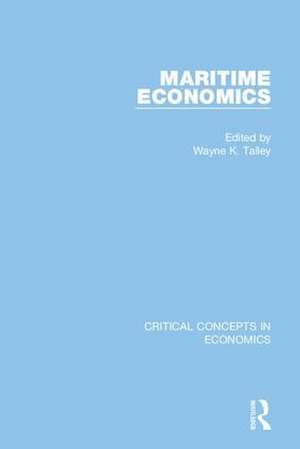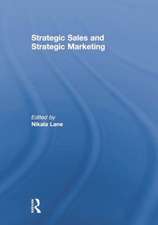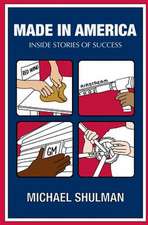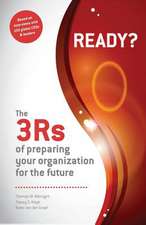Maritime Economics: Critical Concepts in Economics
Editat de Wayne Talleyen Limba Engleză Hardback – 16 feb 2017
Maritime Economics is edited by Wayne K. Talley, a leading scholar in the field, and includes a comprehensive introduction which places the collected material in its historical and intellectual context. This essential collection is destined to be valued by advanced students and researchers of Economics, Maritime Studies, Marine Technology, and International Business and Trade as a vital one-stop resource.
Din seria Critical Concepts in Economics
- 34%
 Preț: 3689.81 lei
Preț: 3689.81 lei - 34%
 Preț: 4243.64 lei
Preț: 4243.64 lei - 34%
 Preț: 4377.43 lei
Preț: 4377.43 lei - 34%
 Preț: 3956.84 lei
Preț: 3956.84 lei - 34%
 Preț: 3961.32 lei
Preț: 3961.32 lei - 34%
 Preț: 5223.59 lei
Preț: 5223.59 lei - 36%
 Preț: 5495.14 lei
Preț: 5495.14 lei - 34%
 Preț: 6743.26 lei
Preț: 6743.26 lei - 34%
 Preț: 6746.51 lei
Preț: 6746.51 lei - 34%
 Preț: 4370.77 lei
Preț: 4370.77 lei - 34%
 Preț: 6741.63 lei
Preț: 6741.63 lei - 34%
 Preț: 6737.14 lei
Preț: 6737.14 lei - 34%
 Preț: 6747.74 lei
Preț: 6747.74 lei - 34%
 Preț: 6742.03 lei
Preț: 6742.03 lei - 33%
 Preț: 1857.25 lei
Preț: 1857.25 lei - 34%
 Preț: 6191.45 lei
Preț: 6191.45 lei - 34%
 Preț: 5629.25 lei
Preț: 5629.25 lei - 34%
 Preț: 7581.12 lei
Preț: 7581.12 lei - 34%
 Preț: 6198.37 lei
Preț: 6198.37 lei - 34%
 Preț: 4378.92 lei
Preț: 4378.92 lei - 34%
 Preț: 7305.61 lei
Preț: 7305.61 lei - 34%
 Preț: 6746.93 lei
Preț: 6746.93 lei - 34%
 Preț: 6189.80 lei
Preț: 6189.80 lei - 34%
 Preț: 6737.14 lei
Preț: 6737.14 lei - 34%
 Preț: 4231.59 lei
Preț: 4231.59 lei - 34%
 Preț: 6737.70 lei
Preț: 6737.70 lei - 34%
 Preț: 6693.08 lei
Preț: 6693.08 lei - 34%
 Preț: 5071.50 lei
Preț: 5071.50 lei
Preț: 4187.95 lei
Preț vechi: 6368.76 lei
-34% Nou
Puncte Express: 6282
Preț estimativ în valută:
801.47€ • 833.65$ • 661.66£
801.47€ • 833.65$ • 661.66£
Carte tipărită la comandă
Livrare economică 14-28 aprilie
Preluare comenzi: 021 569.72.76
Specificații
ISBN-13: 9781138938595
ISBN-10: 1138938599
Pagini: 2060
Dimensiuni: 156 x 234 mm
Greutate: 0.45 kg
Ediția:1
Editura: Taylor & Francis
Colecția Routledge
Seria Critical Concepts in Economics
Locul publicării:Oxford, United Kingdom
ISBN-10: 1138938599
Pagini: 2060
Dimensiuni: 156 x 234 mm
Greutate: 0.45 kg
Ediția:1
Editura: Taylor & Francis
Colecția Routledge
Seria Critical Concepts in Economics
Locul publicării:Oxford, United Kingdom
Public țintă
Postgraduate and UndergraduateCuprins
Volume 1
1. E. Anderson and W. K. Talley, ‘The Oil Spill Size of Tankers and Barge Accidents: Determinants and Policy Implications’, Land Economics, 71, 1995, 216-228.
2. P. Cariou, M.Q.Mejia, Jr. and F-C. Wolff, ‘On the Effectiveness of Port State Control Inspections’, Transportation Research Part E, 44, 2008, 491-503.
3. P. Cariou and A. Cheaitou, ‘Cascading Effects, Network Configurations and Optimal Transshipment Volumes in Liner Shipping’, Maritime Economics & Logistics, 16, 2014, 321-342.
4. K. Cullinane and M. Khanna, ‘Economies of Scale in Large Container Ships’, Journal of Transport Economics and Policy, 33, 1999, 185-208.
5. E. G. Frankel, ‘Port or Shipping Project Appraisal Under Risk’, Maritime Policy and Management, 16, 1989, 213-221.
6. E. G. Frankel, ‘The Economics of Technological Change in Shipping’, Maritime Policy and Management, 18 1991, 43-53.
7. X. Fu, A. K. Y. Ng and Y.-Y. Lau, ‘The Impacts of Maritime Piracy on Global Economic Development: The Case of Somalia’, Maritime Policy and Management, 37, 2010, 677-697.
8. B. Gardner and P. Marlow, ‘An International Comparison of the Fiscal Treatment of Shipping’, Journal of Industrial Economics, 31, 1983, 397-415.
9. D. R. Glen, ‘The Modelling of Dry Bulk and Tanker Markets: A Survey’, Maritime Policy and Management, 33, 2006, 431-445.
10. R. O. Goss, ‘The Turnaround of Cargo Liners and its Effect on Sea Transport Costs’, Journal of Transport Economics and Policy, 1, 1967, 75-89.
11. T.D. Heaver, ‘The Structure of Liner Conference Rates’, Journal of Industrial Economics, 21, 1973, 257-265.
12. T. D. Heaver, H. Meersman, F. Moglia and E. Van de Voorde, ‘Do Mergers and Alliances Influence European Shipping and Port Competition?’, Maritime Policy and Management, 27, 2000, 363-373.
13. L. Jiang, E. Bastiansen and S. P. Strandenes, ‘The International Competitiveness of China’s Shipbuilding Industry’, Transportation Research Part E, 60, 2013, 39-48.
14. H.-J. Kim, Y.-T. Chang, K.-T. Kim and H.J. Kim, ‘An Epsilon-Optimal Algorithm Considering Greenhouse Gas Emissions for the Management of a Ship’s Bunker Fuel’, Transportation Research Part D, 17, 2012, 97-103.
15.Y.-Y Lau, A. K. Y.Ng, X. Fu and K. X. Li, ‘Evolution and Research Trends of Container Shipping’, Maritime Policy and Management, 40, 2013, 654-674.
16. H. Leggate and J. McConville, ‘Tonnage Tax: Is It Working?’ Maritime Policy and Management, 32, 2005, 177-186.
17. L. Li, B. Wang and D. P. Cook, ‘Enhancing Green Supply Chain Initiatives via Empty Container Reuse’, Transportation Research Part E, 70, 2014, 190-204.
18. Y. H. V. Lun, K.-H.Lai, C. W. Y. Wong and T.C.E. Cheng, ‘Demand Chain Management in the Container Shipping Service Industry’, International Journal of Production Economics, 141, 2013, 485-492.
19. S. M. Puckett, D. A. Hensher, M. R. Brooks and V. Trifts, ‘Preferences for Alternative Short Sea Shipping Opportunities’, Transportation Research Part E, 47, 2011, 182-189.
20. D. Shneerson, ‘The Structure of Liner Freight Rates: A Comparative Route Study’, Journal of Transport Economics and Policy, 10, 1976, 52-67.
21. A. W. Veenstra and H. Haralambides, ‘Multivariate Autoregressive Models for Forecasting Seaborne Trade Flows’, Transportation Research Part E, 37, 2001, 311-319.
22. J. J. Xu, T. L. Yip and P. B. Marlow, ‘The Dynamics Between Freight Volatility and Fleet Size Growth in Dry Bulk Shipping Markets’, Transportation Research Part E, 47, 2011, 983-991.
Volume 2
23. R. Adland and K. Cullinane, ‘A Time-Varying Risk Premium in the Term Structure of Bulk Shipping Freight Rates’, Journal of Transport Economics and Policy, 39, 2005, 191-208.
24. R. Agarwal and Ö Ergun, ‘Ship Scheduling and Network Design for Cargo Routing in Liner Shipping’, Transportation Science, 42, 2008, 175-196.
25. A. H. Alizadeh and N. K. Nomikos, ‘Investment Timing and Trading Strategies in the Sale and Purchase Market for Ships’, Transportation Research Part B, 41, 2007, 126-143.
26. H. Andersson, K. Fagerholt and K. Hobbesland, ‘Integrated Maritime Fleet Deployment and Speed Optimization: Case Study from RoRo Shipping’, Computers & Operations Research, 55, 2015, 233-240.
27. P. C. Andreou, C. Louca and P. M. Panayides, ‘Corporate Governance, Financial Management Decisions and Firm Performance: Evidence from the Maritime Industry’, Transportation Research Part E, 63, 2014, 59-78.
28. M. G. H. Bell, X. Liu, P. Angeloudis, A. Fonzone and S. H. Hosseinloo, ‘A Frequency-Based Maritime Container Assignment Model’, Transportation Research Part B, 45, 2011, 1152-1161.
29. M. Christiansen, K. Fagerholt, B. Nygreen and D. Ronen, ‘Ship Routing and Scheduling in the New Millennium’, European Journal of Operational Research, 228, 2013, 467-483.
30. C. Th. Grammenos, A. H. Alizadeh and N. C. Papapostolou, ‘Factors Affecting the Dynamics of Yield Premia on Shipping Seasoned High Yield Bonds’, Transportation Research Part E, 43, 2007, 549-564.
31. C. Th. Grammenos, N. K. Nomikos and N. C. Papapostolou, ‘Estimating the Probability of Default for Shipping High Yield Bond Issues’, Transportation Research Part E, 44, 2008, 1123-1138.
32. M. G. Kavussanos and D. A. Tsouknidis, ‘The Determinants of Credit Spreads Changes in Global Shipping Bonds’, Transportation Research Part E, 70, 2014, 55-75.
33. M. Kavussanos, I. Visvikis and D. Dimitrakopoulvs, ‘Economic Spillovers Between Related Derivatives Markets: The Case of Commodity and Freight Markets’, Transportation Research Part E, 68, 2014, 79-102.
34. S. Kohn and H. A. Thanopoulou, ‘A Gam Assessment of Quality Premia in the Dry Bulk Time-Charter Market’, Transportation Research Part E, 47, 2011, 709-721.
35. Q. Meng, S. Wang, H. Andersson and K. Thun, ‘Containership Routing and Scheduling in Liner Shipping: Overview and Future Research Directions, Transportation Science, 48, 2014, 265-280.
36. M. Ng, ‘Distribution-Free Vessel Deployment for Liner Shipping’, European Journal of Operational Research, 238, 2014, 858-862.
37. P. M. Panayides, N. Lambertides and C. S. Savva, ‘The Relative Efficiency of Shipping Companies’, Transportation Research Part E, 47, 2011, 681-694.
38. G. Pantuso, K. Fagerholt and L. M. Hvattum, ‘A Survey on Maritime Fleet Size and Mix Problems’, European Journal of Operational Research, 235, 2014, 341-349.
39. N. C. Papapostolou, N. K. Nomikos, P. K. Pouliasis and I. Kyriakou, ‘Investor Sentiment for Real Assets: The Case of Dry Bulk Shipping Market’, Review of Finance, 18, 2013, 1 - 33.
40. D. Ronen, ‘The Effect of Oil Price on the Optimal Speed of Ships’, Journal of the Operational
Research Society, 33, 1982, 1035-1040.
41. W. K. Talley, ‘Maritime Transport Chains: Carrier, Port and Shipper Choice Effects’, International Journal of Production Economics, 151, 2014, 174-179.
42. M. N.Tamvakis and H. A. Thanopoulou, ‘Does Quality Pay? The Case of the Dry Bulk Market’, Transportation Research Part E, 36, 2000, 297-307.
43. S. Wang, ‘A Novel Hybrid-Link-Based Container Routing Model’, Transportation Research Part E, 61, 2014, 165-175.
44. S. Wang and Q. Meng, ‘Liner Ship Fleet Deployment with Container Transshipment Operations’, Transportation Research Part E, 48, 2012, 470-484.
45. S. Wang and Q. Meng, ‘Sailing Speed Optimization for Containerships in a Liner Shipping Network’, Transportation Research Part E, 48, 2012, 701-714.
Volume 3
46. K. Bichou and R. Gray, ‘A Logistics and Supply Chain Management Approach to Port
Performance Measurement’, Maritime Policy and Management 31, 2004, 47-67.
47. M. R. Brooks and A. A. Pallis, ‘Assessing Port Governance Models: Process and Performance Components’, Maritime Policy and Management, 35, 2008, 411-432.
48. K. Cullinane and Y. Wang, ‘The Hierarchical Configuration of the Container Port Industry: An Application of Multiple Linkage Analysis’, Maritime Policy and Management, 39, 2012, 169-187.
49. R. O. Goss, ‘Towards an Economic Appraisal of Port Investment’, Journal of Transport Economics and Policy, 1, 1967, 249-272.
50. E. Haezendonck, M. Dooms and A. Verbeke, ‘A New Governance Perspective on Port-Hinterland Relationships: The Port Hinterland Impact (PHI) Matrix’, Maritime Economics & Logistics, 16, 229-249.
51.T. Heaver, H. Meersman and E. Van De Voorde, ‘Co-Operation and Competition in International Container Transport: Strategies for Ports’, Maritime Policy and Management, 28, 2001, 293-305.
52. K. Li and H. Zheng, ‘Enforcement of Law by the Port State Control (PSC)’, Maritime Policy and Management, 35, 2008, 61-71.
53. P. B. Marlow and A. C. Paixao Casaca, ‘Measuring Lean Ports Performance’, International Journal of Transport Management 1, 2003, 189-202.
54. T. E. Notteboom and W. Winkelmans, ‘Structural Changes in Logistics: How Will Port Authorities Face the Challenge?’, Maritime Policy and Management, 28, 2001, 71-89.
55. A. A. Pallis, T. E. Notteboom and P. W. De Langen, ‘Concession Agreements and Market Entry in the Container Terminal Industry’, Maritime Economics & Logistics, 10, 2008, 209–228.
56. S. J. Pettit and A. K. C. Beresford, ‘Port Development: From Gateways to Logistics Hubs’, Maritime Policy and Management, 36, 2009, 253-267.
57. R. Robinson, ‘Ports as Elements in Value-Driven Chain Systems: the New Paradigm’, Maritime Policy and Management, 29, 2002, 241-255.
58. D.-W. Song, ‘Port Co-Opetition in Concept and Practice’, Maritime Policy and Management, 30, 2003, 29-44.
59. D.-W. Song and P. M. Panayides, ‘Global Supply Chain and Port/Terminal: Integration and Competitiveness’, Maritime Policy and Management, 35, 2008, 73-87.
60. S. P. Strandenes, ‘Port Pricing Structures and Ship Efficiency’, Review of Network Economics, 3, 2004, 135-144.
61. W. K. Talley, ‘Dockworker Earnings, Containerisation and Shipping Deregulation’, Journal of Transport Economics and Policy, 36, 2002, 447 - 467.
62. M. R. Van Der Horst and P. W. De Langen, ‘Coordination in Hinterland Transport Chains: A Major Challenge for the Seaport Community’, Maritime Economics & Logistics, 10, 2008, 108-129.
63. A. W. Veenstra, R. Zuidwijk and E. Van Asperen, ‘The Extended Gate Concept for Container Terminals: Expanding the Notion of Dry Ports’, Maritime Economics & Logistics, 14, 2012, 14-32.
64. P. Verhoeven, ‘A Review of Port Authority Functions: Towards a Renaissance’, Maritime Policy And Management, 37, 2010, 247-270.
65. G. Wilmsmeier and J. Hoffmann, ‘Liner Shipping Connectivity and Port Infrastructure as Determinants of Freight Rates in the Caribbean’, Maritime Economics & Logistics. 10, 2008, 130–151.
Volume 4
66. C. Bierwirth and F. Meisel, ‘A Follow-Up Survey of Berth Allocation and Quay Crane Scheduling Problems in Container Terminals’, European Journal of Operational Research, 244, 2015, 675-689.
67. H. J. Carlo, I. F. A. Vis and K. J. Roodbergen, ‘Storage Yard Operations in Container Terminals: Literature Overview, Trends, and Research Directions’, European Journal of Operational Research, 235, 2014, 412-430.
68. D. Chang, Z. Jiang, W. Yan and J. He, ‘Integrating Berth Allocation and Quay Crane Assignments’, Transportation Research Part E, 46, 2010, 975-990.
69. L. Chen, A. Langevin and Z. Lu, ‘Integrated Scheduling of Crane Handling and Truck Transportation in a Maritime Container Terminal’, European Journal of Operational Research, 225, 2013, 142-152.
70. S. Dekker, R. Verhaeghe and B. Wiegmans, ‘Economically-Efficient Port Expansion Strategies: An Optimal Control Approach’, Transportation Research Part E, 47, 2011, 201-215.
71. A. Imai, E. Nishimura and S. Papadimitriou, ‘Marine Container Terminal Configurations for Efficient Handling of Mega-Containerships’, Transportation Research Part E, 49, 2013, 141-158.
72. M. Ishii, P. T.-W.Lee, K. Tezuka and Y.-T. Chang, ‘A Game Theoretical Analysis of Port Competition’, Transportation Research Part E, 49, 2013, 92-106.
73. J. Jiang, L. H. Lee, E. P. Chew and C. C. Gan, ‘Port Connectivity Study: An Analysis Framework from a Global Container Liner Shipping Network Perspective’, Transportation Research Part E, 73, 2015, 47-64.
74. D.-H. Lee and J. G. Jin, ‘Feeder Vessel Management at Container Transshipment Terminals’, Transportation Research Part E, 49, 2013, 201-216.
75. F. Meisel and C. Bierwirth, ‘A Framework for Integrated Berth Allocation and Crane Operations Planning in Seaport Container Terminals’, Transportation Science, 47, 2013, 131-147.
76. J. Nossack and E. Pesch, ‘A Truck Scheduling Problem Arising in Intermodal Container Transportation’, European Journal of Operational Research, 230, 2013, 666-680.
77. X. Qiu, J. S. L. Lam and G. Q. Huang, ‘A Bilevel Storage Pricing Model for Outbound Containers in a Dry Port System’, Transportation Research Part E, 73, 2015, 65-83.
78. S. Sauri and F. Robuste, ‘Promoting Incentives: Performance Improvement in Container Port Terminals’, Transportation Science, 46, 2012, 233-246.
79. W. K. Talley, M. Ng and E. Marsillac, ‘Port Service Chains and Port Performance Evaluation’, Transportation Research Part E, 69, 2014, 236-247.
80. W. K. Talley and M. Ng, ‘Port Economic Cost Functions: A Service Perspective’, Transportation Research Part E, 88, 2016, 1-10.
81. K. Tierney, S. VoB and R. Stahlbock, ‘A Mathematical Model of Inter-Terminal Transportation’, European Journal of Operational Research, 235, 2014, 448-460.
82. J. L. Tongzon, ‘Port Choice and Freight Forwarders’, Transportation Research Part E, 45, 2009, 186-195.
83. G. W. Y. Wang and A. A. Pallis, ‘Incentive Approaches to Overcome Moral Hazard in Port Concession Agreements’, Transportation Research Part E, 67, 2014, 162-174.
84. G.-T.Yeo, D. Song J. Dinwoodie and M. Roe, ‘Weighting the Competitiveness Factors for Container Ports Under Conflicting Interests’, Journal of the Operational Research Society, 61, 2010, 1249-1257.
85. T. L. Yip, ‘Port Traffic Risks – A Study of Accidents in Hong Kong Waters’, Transportation Research Part E, 44, 2008, 921-931.
86. W. Zhao and A. Goodchild, ‘The Impact of Truck Arrival Information on Container Terminal Re-handling’, Transportation Research Part E, 46, 2010, 327-343.
1. E. Anderson and W. K. Talley, ‘The Oil Spill Size of Tankers and Barge Accidents: Determinants and Policy Implications’, Land Economics, 71, 1995, 216-228.
2. P. Cariou, M.Q.Mejia, Jr. and F-C. Wolff, ‘On the Effectiveness of Port State Control Inspections’, Transportation Research Part E, 44, 2008, 491-503.
3. P. Cariou and A. Cheaitou, ‘Cascading Effects, Network Configurations and Optimal Transshipment Volumes in Liner Shipping’, Maritime Economics & Logistics, 16, 2014, 321-342.
4. K. Cullinane and M. Khanna, ‘Economies of Scale in Large Container Ships’, Journal of Transport Economics and Policy, 33, 1999, 185-208.
5. E. G. Frankel, ‘Port or Shipping Project Appraisal Under Risk’, Maritime Policy and Management, 16, 1989, 213-221.
6. E. G. Frankel, ‘The Economics of Technological Change in Shipping’, Maritime Policy and Management, 18 1991, 43-53.
7. X. Fu, A. K. Y. Ng and Y.-Y. Lau, ‘The Impacts of Maritime Piracy on Global Economic Development: The Case of Somalia’, Maritime Policy and Management, 37, 2010, 677-697.
8. B. Gardner and P. Marlow, ‘An International Comparison of the Fiscal Treatment of Shipping’, Journal of Industrial Economics, 31, 1983, 397-415.
9. D. R. Glen, ‘The Modelling of Dry Bulk and Tanker Markets: A Survey’, Maritime Policy and Management, 33, 2006, 431-445.
10. R. O. Goss, ‘The Turnaround of Cargo Liners and its Effect on Sea Transport Costs’, Journal of Transport Economics and Policy, 1, 1967, 75-89.
11. T.D. Heaver, ‘The Structure of Liner Conference Rates’, Journal of Industrial Economics, 21, 1973, 257-265.
12. T. D. Heaver, H. Meersman, F. Moglia and E. Van de Voorde, ‘Do Mergers and Alliances Influence European Shipping and Port Competition?’, Maritime Policy and Management, 27, 2000, 363-373.
13. L. Jiang, E. Bastiansen and S. P. Strandenes, ‘The International Competitiveness of China’s Shipbuilding Industry’, Transportation Research Part E, 60, 2013, 39-48.
14. H.-J. Kim, Y.-T. Chang, K.-T. Kim and H.J. Kim, ‘An Epsilon-Optimal Algorithm Considering Greenhouse Gas Emissions for the Management of a Ship’s Bunker Fuel’, Transportation Research Part D, 17, 2012, 97-103.
15.Y.-Y Lau, A. K. Y.Ng, X. Fu and K. X. Li, ‘Evolution and Research Trends of Container Shipping’, Maritime Policy and Management, 40, 2013, 654-674.
16. H. Leggate and J. McConville, ‘Tonnage Tax: Is It Working?’ Maritime Policy and Management, 32, 2005, 177-186.
17. L. Li, B. Wang and D. P. Cook, ‘Enhancing Green Supply Chain Initiatives via Empty Container Reuse’, Transportation Research Part E, 70, 2014, 190-204.
18. Y. H. V. Lun, K.-H.Lai, C. W. Y. Wong and T.C.E. Cheng, ‘Demand Chain Management in the Container Shipping Service Industry’, International Journal of Production Economics, 141, 2013, 485-492.
19. S. M. Puckett, D. A. Hensher, M. R. Brooks and V. Trifts, ‘Preferences for Alternative Short Sea Shipping Opportunities’, Transportation Research Part E, 47, 2011, 182-189.
20. D. Shneerson, ‘The Structure of Liner Freight Rates: A Comparative Route Study’, Journal of Transport Economics and Policy, 10, 1976, 52-67.
21. A. W. Veenstra and H. Haralambides, ‘Multivariate Autoregressive Models for Forecasting Seaborne Trade Flows’, Transportation Research Part E, 37, 2001, 311-319.
22. J. J. Xu, T. L. Yip and P. B. Marlow, ‘The Dynamics Between Freight Volatility and Fleet Size Growth in Dry Bulk Shipping Markets’, Transportation Research Part E, 47, 2011, 983-991.
Volume 2
23. R. Adland and K. Cullinane, ‘A Time-Varying Risk Premium in the Term Structure of Bulk Shipping Freight Rates’, Journal of Transport Economics and Policy, 39, 2005, 191-208.
24. R. Agarwal and Ö Ergun, ‘Ship Scheduling and Network Design for Cargo Routing in Liner Shipping’, Transportation Science, 42, 2008, 175-196.
25. A. H. Alizadeh and N. K. Nomikos, ‘Investment Timing and Trading Strategies in the Sale and Purchase Market for Ships’, Transportation Research Part B, 41, 2007, 126-143.
26. H. Andersson, K. Fagerholt and K. Hobbesland, ‘Integrated Maritime Fleet Deployment and Speed Optimization: Case Study from RoRo Shipping’, Computers & Operations Research, 55, 2015, 233-240.
27. P. C. Andreou, C. Louca and P. M. Panayides, ‘Corporate Governance, Financial Management Decisions and Firm Performance: Evidence from the Maritime Industry’, Transportation Research Part E, 63, 2014, 59-78.
28. M. G. H. Bell, X. Liu, P. Angeloudis, A. Fonzone and S. H. Hosseinloo, ‘A Frequency-Based Maritime Container Assignment Model’, Transportation Research Part B, 45, 2011, 1152-1161.
29. M. Christiansen, K. Fagerholt, B. Nygreen and D. Ronen, ‘Ship Routing and Scheduling in the New Millennium’, European Journal of Operational Research, 228, 2013, 467-483.
30. C. Th. Grammenos, A. H. Alizadeh and N. C. Papapostolou, ‘Factors Affecting the Dynamics of Yield Premia on Shipping Seasoned High Yield Bonds’, Transportation Research Part E, 43, 2007, 549-564.
31. C. Th. Grammenos, N. K. Nomikos and N. C. Papapostolou, ‘Estimating the Probability of Default for Shipping High Yield Bond Issues’, Transportation Research Part E, 44, 2008, 1123-1138.
32. M. G. Kavussanos and D. A. Tsouknidis, ‘The Determinants of Credit Spreads Changes in Global Shipping Bonds’, Transportation Research Part E, 70, 2014, 55-75.
33. M. Kavussanos, I. Visvikis and D. Dimitrakopoulvs, ‘Economic Spillovers Between Related Derivatives Markets: The Case of Commodity and Freight Markets’, Transportation Research Part E, 68, 2014, 79-102.
34. S. Kohn and H. A. Thanopoulou, ‘A Gam Assessment of Quality Premia in the Dry Bulk Time-Charter Market’, Transportation Research Part E, 47, 2011, 709-721.
35. Q. Meng, S. Wang, H. Andersson and K. Thun, ‘Containership Routing and Scheduling in Liner Shipping: Overview and Future Research Directions, Transportation Science, 48, 2014, 265-280.
36. M. Ng, ‘Distribution-Free Vessel Deployment for Liner Shipping’, European Journal of Operational Research, 238, 2014, 858-862.
37. P. M. Panayides, N. Lambertides and C. S. Savva, ‘The Relative Efficiency of Shipping Companies’, Transportation Research Part E, 47, 2011, 681-694.
38. G. Pantuso, K. Fagerholt and L. M. Hvattum, ‘A Survey on Maritime Fleet Size and Mix Problems’, European Journal of Operational Research, 235, 2014, 341-349.
39. N. C. Papapostolou, N. K. Nomikos, P. K. Pouliasis and I. Kyriakou, ‘Investor Sentiment for Real Assets: The Case of Dry Bulk Shipping Market’, Review of Finance, 18, 2013, 1 - 33.
40. D. Ronen, ‘The Effect of Oil Price on the Optimal Speed of Ships’, Journal of the Operational
Research Society, 33, 1982, 1035-1040.
41. W. K. Talley, ‘Maritime Transport Chains: Carrier, Port and Shipper Choice Effects’, International Journal of Production Economics, 151, 2014, 174-179.
42. M. N.Tamvakis and H. A. Thanopoulou, ‘Does Quality Pay? The Case of the Dry Bulk Market’, Transportation Research Part E, 36, 2000, 297-307.
43. S. Wang, ‘A Novel Hybrid-Link-Based Container Routing Model’, Transportation Research Part E, 61, 2014, 165-175.
44. S. Wang and Q. Meng, ‘Liner Ship Fleet Deployment with Container Transshipment Operations’, Transportation Research Part E, 48, 2012, 470-484.
45. S. Wang and Q. Meng, ‘Sailing Speed Optimization for Containerships in a Liner Shipping Network’, Transportation Research Part E, 48, 2012, 701-714.
Volume 3
46. K. Bichou and R. Gray, ‘A Logistics and Supply Chain Management Approach to Port
Performance Measurement’, Maritime Policy and Management 31, 2004, 47-67.
47. M. R. Brooks and A. A. Pallis, ‘Assessing Port Governance Models: Process and Performance Components’, Maritime Policy and Management, 35, 2008, 411-432.
48. K. Cullinane and Y. Wang, ‘The Hierarchical Configuration of the Container Port Industry: An Application of Multiple Linkage Analysis’, Maritime Policy and Management, 39, 2012, 169-187.
49. R. O. Goss, ‘Towards an Economic Appraisal of Port Investment’, Journal of Transport Economics and Policy, 1, 1967, 249-272.
50. E. Haezendonck, M. Dooms and A. Verbeke, ‘A New Governance Perspective on Port-Hinterland Relationships: The Port Hinterland Impact (PHI) Matrix’, Maritime Economics & Logistics, 16, 229-249.
51.T. Heaver, H. Meersman and E. Van De Voorde, ‘Co-Operation and Competition in International Container Transport: Strategies for Ports’, Maritime Policy and Management, 28, 2001, 293-305.
52. K. Li and H. Zheng, ‘Enforcement of Law by the Port State Control (PSC)’, Maritime Policy and Management, 35, 2008, 61-71.
53. P. B. Marlow and A. C. Paixao Casaca, ‘Measuring Lean Ports Performance’, International Journal of Transport Management 1, 2003, 189-202.
54. T. E. Notteboom and W. Winkelmans, ‘Structural Changes in Logistics: How Will Port Authorities Face the Challenge?’, Maritime Policy and Management, 28, 2001, 71-89.
55. A. A. Pallis, T. E. Notteboom and P. W. De Langen, ‘Concession Agreements and Market Entry in the Container Terminal Industry’, Maritime Economics & Logistics, 10, 2008, 209–228.
56. S. J. Pettit and A. K. C. Beresford, ‘Port Development: From Gateways to Logistics Hubs’, Maritime Policy and Management, 36, 2009, 253-267.
57. R. Robinson, ‘Ports as Elements in Value-Driven Chain Systems: the New Paradigm’, Maritime Policy and Management, 29, 2002, 241-255.
58. D.-W. Song, ‘Port Co-Opetition in Concept and Practice’, Maritime Policy and Management, 30, 2003, 29-44.
59. D.-W. Song and P. M. Panayides, ‘Global Supply Chain and Port/Terminal: Integration and Competitiveness’, Maritime Policy and Management, 35, 2008, 73-87.
60. S. P. Strandenes, ‘Port Pricing Structures and Ship Efficiency’, Review of Network Economics, 3, 2004, 135-144.
61. W. K. Talley, ‘Dockworker Earnings, Containerisation and Shipping Deregulation’, Journal of Transport Economics and Policy, 36, 2002, 447 - 467.
62. M. R. Van Der Horst and P. W. De Langen, ‘Coordination in Hinterland Transport Chains: A Major Challenge for the Seaport Community’, Maritime Economics & Logistics, 10, 2008, 108-129.
63. A. W. Veenstra, R. Zuidwijk and E. Van Asperen, ‘The Extended Gate Concept for Container Terminals: Expanding the Notion of Dry Ports’, Maritime Economics & Logistics, 14, 2012, 14-32.
64. P. Verhoeven, ‘A Review of Port Authority Functions: Towards a Renaissance’, Maritime Policy And Management, 37, 2010, 247-270.
65. G. Wilmsmeier and J. Hoffmann, ‘Liner Shipping Connectivity and Port Infrastructure as Determinants of Freight Rates in the Caribbean’, Maritime Economics & Logistics. 10, 2008, 130–151.
Volume 4
66. C. Bierwirth and F. Meisel, ‘A Follow-Up Survey of Berth Allocation and Quay Crane Scheduling Problems in Container Terminals’, European Journal of Operational Research, 244, 2015, 675-689.
67. H. J. Carlo, I. F. A. Vis and K. J. Roodbergen, ‘Storage Yard Operations in Container Terminals: Literature Overview, Trends, and Research Directions’, European Journal of Operational Research, 235, 2014, 412-430.
68. D. Chang, Z. Jiang, W. Yan and J. He, ‘Integrating Berth Allocation and Quay Crane Assignments’, Transportation Research Part E, 46, 2010, 975-990.
69. L. Chen, A. Langevin and Z. Lu, ‘Integrated Scheduling of Crane Handling and Truck Transportation in a Maritime Container Terminal’, European Journal of Operational Research, 225, 2013, 142-152.
70. S. Dekker, R. Verhaeghe and B. Wiegmans, ‘Economically-Efficient Port Expansion Strategies: An Optimal Control Approach’, Transportation Research Part E, 47, 2011, 201-215.
71. A. Imai, E. Nishimura and S. Papadimitriou, ‘Marine Container Terminal Configurations for Efficient Handling of Mega-Containerships’, Transportation Research Part E, 49, 2013, 141-158.
72. M. Ishii, P. T.-W.Lee, K. Tezuka and Y.-T. Chang, ‘A Game Theoretical Analysis of Port Competition’, Transportation Research Part E, 49, 2013, 92-106.
73. J. Jiang, L. H. Lee, E. P. Chew and C. C. Gan, ‘Port Connectivity Study: An Analysis Framework from a Global Container Liner Shipping Network Perspective’, Transportation Research Part E, 73, 2015, 47-64.
74. D.-H. Lee and J. G. Jin, ‘Feeder Vessel Management at Container Transshipment Terminals’, Transportation Research Part E, 49, 2013, 201-216.
75. F. Meisel and C. Bierwirth, ‘A Framework for Integrated Berth Allocation and Crane Operations Planning in Seaport Container Terminals’, Transportation Science, 47, 2013, 131-147.
76. J. Nossack and E. Pesch, ‘A Truck Scheduling Problem Arising in Intermodal Container Transportation’, European Journal of Operational Research, 230, 2013, 666-680.
77. X. Qiu, J. S. L. Lam and G. Q. Huang, ‘A Bilevel Storage Pricing Model for Outbound Containers in a Dry Port System’, Transportation Research Part E, 73, 2015, 65-83.
78. S. Sauri and F. Robuste, ‘Promoting Incentives: Performance Improvement in Container Port Terminals’, Transportation Science, 46, 2012, 233-246.
79. W. K. Talley, M. Ng and E. Marsillac, ‘Port Service Chains and Port Performance Evaluation’, Transportation Research Part E, 69, 2014, 236-247.
80. W. K. Talley and M. Ng, ‘Port Economic Cost Functions: A Service Perspective’, Transportation Research Part E, 88, 2016, 1-10.
81. K. Tierney, S. VoB and R. Stahlbock, ‘A Mathematical Model of Inter-Terminal Transportation’, European Journal of Operational Research, 235, 2014, 448-460.
82. J. L. Tongzon, ‘Port Choice and Freight Forwarders’, Transportation Research Part E, 45, 2009, 186-195.
83. G. W. Y. Wang and A. A. Pallis, ‘Incentive Approaches to Overcome Moral Hazard in Port Concession Agreements’, Transportation Research Part E, 67, 2014, 162-174.
84. G.-T.Yeo, D. Song J. Dinwoodie and M. Roe, ‘Weighting the Competitiveness Factors for Container Ports Under Conflicting Interests’, Journal of the Operational Research Society, 61, 2010, 1249-1257.
85. T. L. Yip, ‘Port Traffic Risks – A Study of Accidents in Hong Kong Waters’, Transportation Research Part E, 44, 2008, 921-931.
86. W. Zhao and A. Goodchild, ‘The Impact of Truck Arrival Information on Container Terminal Re-handling’, Transportation Research Part E, 46, 2010, 327-343.
Descriere
Given that commercial shipping has been undertaken for over five thousand years, it is perhaps unsurprising that Maritime Economics is a well-established and flourishing area of research and study. This new four-volume collection answers the growing need for an authoritative reference work to enable users to make better sense of its voluminous literature. This essential collection is destined to be valued by advanced students and researchers of Economics, Maritime Studies, Marine Technology, and International Business and Trade.













